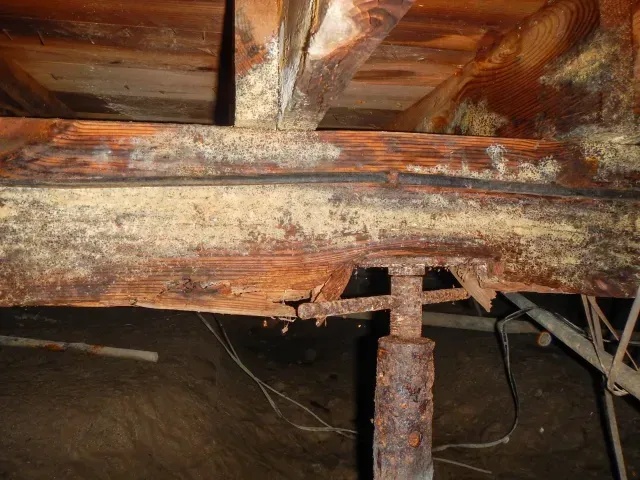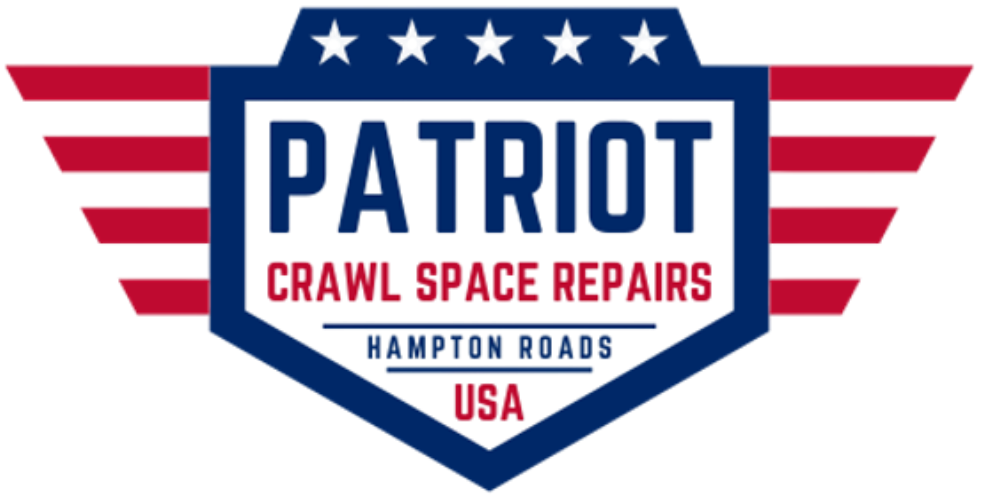The Crawl Space Blog
Expert information and advice on everything crawl space related.
Watch The Youtube Video
How Crawl Space Moisture Damages Your Home

How Crawl Space Moisture Damages Your Home
Most crawl space problems start with one thing: moisture.
When humidity or standing water builds up underneath your home, it doesn’t just create a musty smell — it quietly attacks your wood framing, ductwork, plumbing, and foundation.
At Patriot Crawl Space Repairs, we’ve seen every kind of damage moisture can cause. From soft floor joists to mold-covered ducts, water in your crawl space is never harmless.
Here’s what it’s really doing to your home — and how to stop it.
1. Wood Rot and Structural Damage
Wood is naturally porous, and it constantly absorbs and releases moisture from the air. When humidity in a crawl space stays above 60%, wood fibers start to break down and decay.
You’ll often see:
• Soft, spongy floor joists
• Sagging or uneven floors
• Cracked drywall and sticking doors
• Fungal growth on beams and subflooring
Rotting wood loses its structural strength, which means the weight of the home is no longer evenly supported. Over time, this can lead to costly framing repairs or even foundation shifting.
2. Mold and Mildew Growth
Moisture and darkness are perfect conditions for mold and mildew. As condensation forms on cool surfaces, mold spreads across the joists, insulation, and subfloor. Those spores release gases that create the classic musty crawl space odor — and they don’t stay down there.
Through the stack effect, that damp air rises into your living space, affecting indoor air quality and triggering allergies.
3. Damage to Ductwork
Your HVAC ducts are usually the first things to “sweat” when humidity builds up. Cold air inside the ducts meets humid air outside, and condensation forms on the metal.
That water drips onto:
• Wood framing and insulation
• The vapor barrier
• Duct insulation wrap and flex lines
Before long, the duct insulation and flex lines turn moldy, soggy, and foul-smelling. Rust forms on the metal fittings, and leaks develop at the seams.
If the ducts have gaps, they can even pull crawl space air into your HVAC system — spreading that odor throughout the home.
In severe cases, the only solution is replacing the ductwork after the crawl space has been sealed and dehumidified. Once moisture is under control, new ducts stay clean, dry, and efficient.
4. Corrosion on Plumbing and Pipes
Condensation also collects on cold water lines and drainpipes. Over time, this constant exposure leads to rust, pitting, and corrosion.
Metal pipes may eventually leak, while PVC fittings can loosen as they expand and contract with moisture cycles. Damp soil around the foundation can even accelerate corrosion on plumbing hangers and supports.
5. Foundation and Pier Damage
Standing water and high humidity don’t just affect wood — they attack your foundation piers and footings.
When moisture seeps into masonry, it breaks down the mortar joints and allows efflorescence (white mineral deposits) to form.
If the soil around the piers stays saturated, it can shift and settle unevenly, causing cracks in your subfloor or foundation walls.
This movement creates uneven weight distribution — and that’s when homeowners start noticing sagging floors and cracked walls inside the house.
6. Insulation Failure
Fiberglass insulation in vented crawl spaces quickly becomes a moisture trap.
When it absorbs condensation, it sags, falls, and holds moisture against the wood framing. Wet insulation loses its R-value and becomes a breeding ground for mold, pests, and odor.
Removing the old insulation and sealing the crawl space keeps the area dry and balanced year-round — no more soggy fiberglass or falling batts.
How to Stop Crawl Space Moisture Damage
Moisture control is about air control. Once you seal the space and manage humidity, the damage stops — permanently.
Here’s what we do at Patriot Crawl Space Repairs:
1. Seal the Crawl Space
We close off vents, doors, and gaps to keep humid air from entering.
2. Install a Dehumidifier
A professional-grade dehumidifier maintains 45–55% humidity to stop condensation and mold.
3. Add a 10-Mil Vapor Barrier
We cover the ground with a heavy-duty liner that blocks soil vapor.
4. Remove Wet Insulation
Old fiberglass traps moisture and must be removed so the wood can dry properly.
5. Replace Moldy Ductwork or Flex Lines
We coordinate duct replacement if insulation or lines are moldy or damaged.
6. Address Drainage Issues
If groundwater collects after heavy rain, we install a sump pump and drain system to keep it dry for good.
The Cost of Ignoring Crawl Space Moisture
Ignoring crawl space humidity is like ignoring a roof leak under your house.
The damage might be hidden, but it’s always spreading.
Over time, unchecked moisture leads to:
• Structural repairs and wood replacement
• Mold remediation costs
• Duct and insulation replacement
• Higher energy bills
• Reduced air quality and comfort
The earlier you fix it, the less you’ll spend later.
The Patriot Crawl Space Repairs Approach
We don’t just dry out crawl spaces — we solve the root problem permanently.
Our team:
• Measures humidity and wood moisture content
• Identifies condensation sources and duct leaks
• Designs a moisture-control system based on your crawl space’s layout and conditions
The result is a clean, dry, healthy space that protects your home from the ground up.
Bottom Line
Crawl space moisture quietly destroys your home’s structure, ductwork, and air quality. But with proper sealing, dehumidification, and drainage, you can stop the damage before it spreads.
📞 Call Patriot Crawl Space Repairs or visit patriotcrawlspacerepairs.com to schedule your crawl space inspection today.
We’ll identify your moisture issues, repair any damage, and protect your home for the long term.



